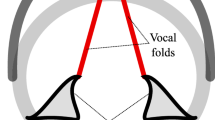Abstract
The linear homeomorphic muscle model proposed by Enderle and coworkers for the rectus eye muscle is fitted to reflect the dynamics of muscles in the head–neck complex, specifically in muscles involved in gaze shifts. This parameterization of the model for different muscles in the neck region will serve to drive a 3D dynamic computer model for the movement of the head–neck complex, including bony structures and soft tissues, and aimed to study the neural control of the complex during fast eye and head movements such as saccades and gaze shifts. Parameter values for the different muscles in the neck region were obtained by optimization using simulated annealing. These linear homeomorphic muscle models provide non-linear force–velocity profiles and linear length tension profiles, which are in agreement with results from the more complex Virtual Muscle model, which is based on Zajac’s non-linear muscle model.











Similar content being viewed by others
References
Bizzi, E., R. E. Kalil, and V. Tagliasco. Eye-head coordination in monkeys: evidence for centrally patterned organization. Science 173:452–454, 1971.
Brelin-Fornari, J., P. Shah, and M. El-Sayed. Physically correlated muscle activation for a human head and neck computational model. Comput. Methods Biomech. Biomed. Eng. 8:191–199, 2005.
Brown, I. E., S. H. Scott, and G. E. Loeb. Mechanics of feline soleus: II design and validation of a mathematical model. J. Muscle Res. Cell Motil. 17:221–233, 1996.
Chang, Y., P. Coddington, and K. Hutchens. The NPAC/OLDA Visible Human Viewer. Adelaide, Australia: Computer Science Department, Adelaide University. www.dhpc.adelaide.edu.au/projects/vishuman2/. Accessed 11 July 2007.
Cheng, E. J., I. E. Brown, and G. E. Loeb. Virtual muscle: a computational approach to understanding the effects of muscle properties on motor control. J. Neurosci. Methods 101:117–130, 2000.
Close, R. I., and A. R. Luff. Dynamic properties of inferior rectus muscle of the rat. J. Physiol. 236:259–270, 1974.
Collins, C. C., D. O’Meara, and A. B. Scott. Muscle tension during unrestrained human eye movements. J. Physiol. 245:351–369, 1975.
Enderle, J. D. A Physiological Neural Network for Saccadic Eye Movement Control. Report AL/AO-TR-1994-0023 prepared for Armstrong Laboratory AL/AOCFO Brooks AFRB, TX, 1994.
Enderle, J. D. Neural control of saccades. Prog. Brain Res. 140:21–49, 2002.
Enderle, J. D., J. D. Bronzino, and S. M. Blanchard. Introduction to Biomedical Engineering, vol. xxi. Amsterdam: Elsevier Academic Press, 1118 pp., 2005.
Enderle, J. D., E. J. Engelken, and R. N. Stiles. A comparison of static and dynamic characteristics between rectus eye muscle and linear muscle model predictions. IEEE Trans. Biomed. Eng. 38:1235–1245, 1991.
Enderle, J. D., and J. W. Wolfe. Time-optimal control of saccadic eye movements. IEEE Trans. Biomed. Eng. 34:43–55, 1987.
Farahat, W., and H. Herr. An apparatus for characterization and control of isolated muscle. IEEE Trans. Neural Syst. Rehabil. Eng. 13:473–481, 2005.
Freedman, E. G. Coordination of the eyes and head during visual orienting. Exp. Brain Res. 190:369–387, 2008.
Freedman, E. G., and D. L. Sparks. Eye-head coordination during head-unrestrained gaze shifts in rhesus monkeys. J. Neurophysiol. 77:2328–2348, 1997.
Hannaford, B. Control of Fast Movement: Human Head Rotation. PhD dissertation, University of California, Berkeley, 1985.
Kamibayashi, L. K., and F. J. Richmond. Morphometry of human neck muscles. Spine 23:1314–1323, 1998.
Kirkpatrick, S., C. D. Gelatt, Jr., and M. P. Vecchi. Optimization by simulated annealing. Science 220:671–680, 1983.
Lestienne, F., P. P. Vidal, and A. Berthoz. Gaze changing behaviour in head restrained monkey. Exp. Brain Res. 53:349–356, 1984.
Morasso, P., G. Sandini, V. Tagliasco, and R. Zaccaria. Control strategies in the eye-head coordination system. IEEE Trans. Syst. Man Cybern. 7:639–651, 1977.
Neptune, R. R. Optimization algorithm performance in determining optimal controls in human movement analyses. J. Biomech. Eng. 121:249–252, 1999.
Quaia, C., H. S. Ying, A. M. Nichols, and L. M. Optican. The viscoelastic properties of passive eye muscle in primates. I. Static and step responses. PLoS One 4:e4850, 2009.
Richmond, F. J., K. Singh, and B. D. Corneil. Neck muscles in the rhesus monkey. I. Muscle morphometry and histochemistry. J. Neurophysiol. 86:1717–1728, 2001.
Scudder, C. A., C. S. Kaneko, and A. F. Fuchs. The brainstem burst generator for saccadic eye movements: a modern synthesis. Exp. Brain Res. 142:439–462, 2002.
Song, D., G. Raphael, N. Lan, and G. E. Loeb. Computationally efficient models of neuromuscular recruitment and mechanics. J. Neural Eng. 5:175–184, 2008.
Sylvestre, P. A., and K. E. Cullen. Premotor correlates of integrated feedback control for eye-head gaze shifts. J. Neurosci. 26:4922–4929, 2006.
Vandekerckhove, J. General Simulated Annealing Algorithm, 2006. http://www.mathworks.com/matlabcentral/fileexchange/10548. Accessed 14 July 2008.
Van Lopik, D. W., and M. Acar. Development of a multi-body computational model of human head and neck. Proc. Inst. Mech. Eng. Part K: J. Multi-body Dyn. 221:175–197, 2007.
Vasavada, A. N., S. Li, and S. L. Delp. Influence of muscle morphometry and moment arms on the moment-generating capacity of human neck muscles. Spine 23:412–422, 1998.
Zajac, F. E. Muscle and tendon: properties, models, scaling, and application to biomechanics and motor control. Crit. Rev. Biomed. Eng. 17:359–411, 1989.
Zangemeister, W. H., A. C. Arlt, and S. Lehman. Sensitivity functions of a human head movement model. Med. Eng. Phys. 16:163–170, 1994.
Zangemeister, W. H., L. Stark, O. Meienberg, and T. Waite. Neural control of head rotation: electromyographic evidence. J. Neurol. Sci. 55:1–14, 1982.
Author information
Authors and Affiliations
Corresponding author
Rights and permissions
About this article
Cite this article
Sierra, D.A., Enderle, J.D. Linear Homeomorphic Models for Muscles in the Head–Neck Region. Ann Biomed Eng 38, 247–258 (2010). https://doi.org/10.1007/s10439-009-9851-6
Received:
Accepted:
Published:
Issue Date:
DOI: https://doi.org/10.1007/s10439-009-9851-6




